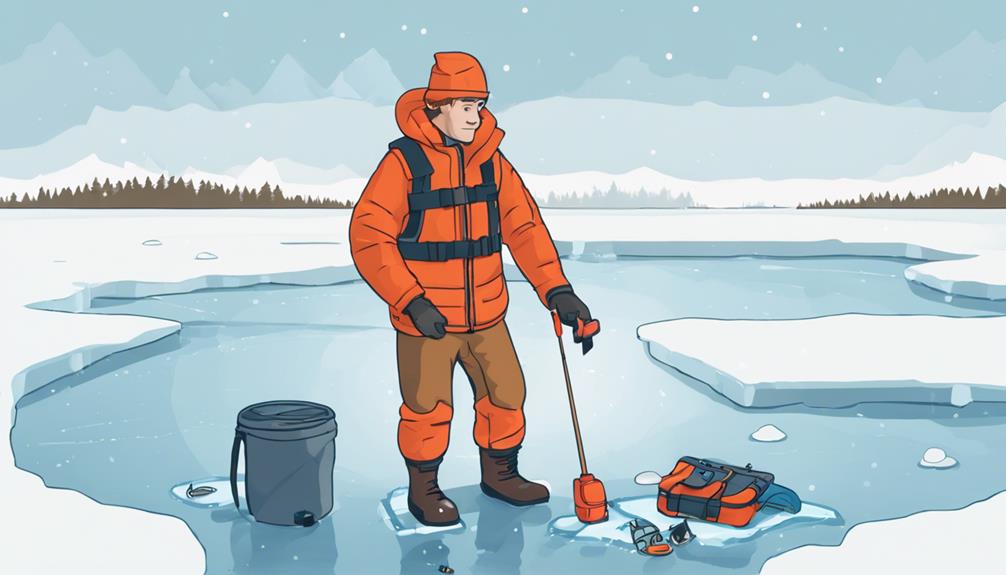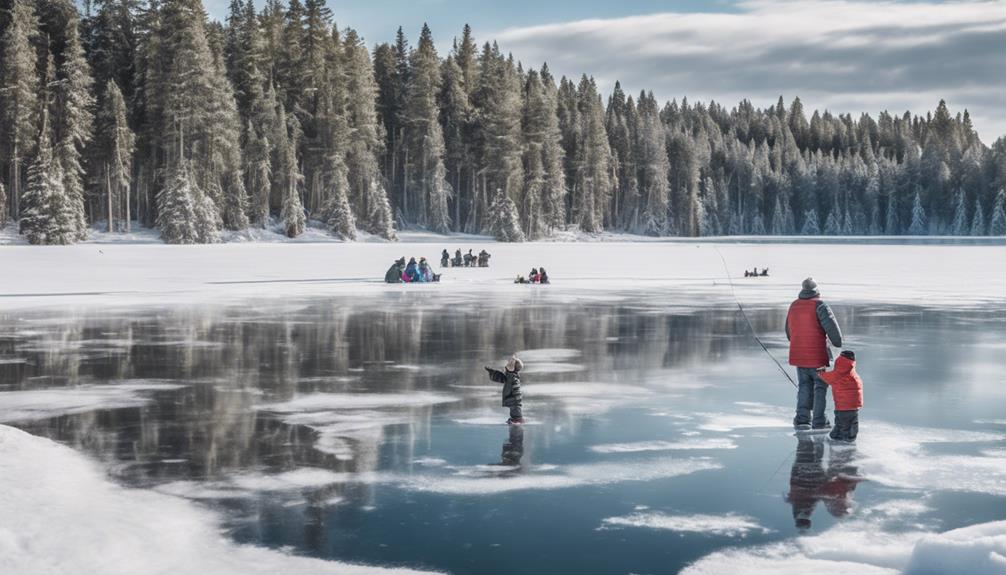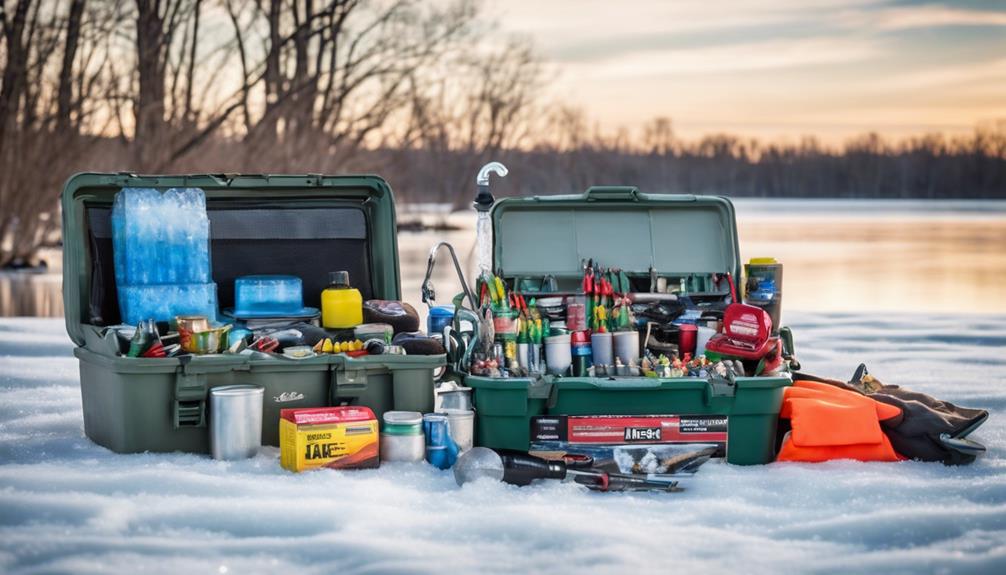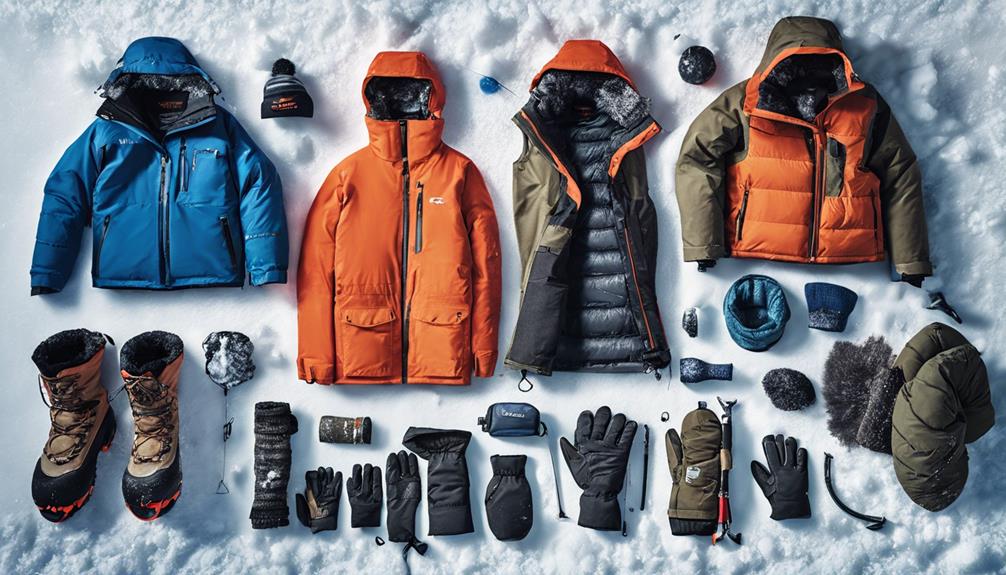Ever experienced the thrill of ice fishing and thought, “Who needs safety precautions anyway?” Well, hold that thought. Safety in ice fishing is not just about rules and regulations; it's a matter of life and death.
Imagine being out on the frozen lake, enjoying the tranquility, when suddenly, the ice beneath you gives way. Stay tuned to uncover the critical reasons why ensuring safety in ice fishing is non-negotiable.
Importance of Safety Gear
Ensuring you have the proper safety gear is crucial when engaging in ice fishing. Proper insulation is essential to protect yourself from the extreme cold temperatures. Dressing in layers with thermal clothing, waterproof outerwear, and insulated boots will help keep you warm and dry throughout your fishing excursion. It's important to prioritize visibility by wearing bright colors or reflective gear, especially during low light conditions or in case of emergencies.
Emergency communication devices are vital for staying safe on the ice. Carrying a fully charged cell phone or a two-way radio can be a lifeline in case of an emergency. Additionally, having a whistle or a signal flare can help draw attention if you find yourself in a dangerous situation. First aid kits are a must-have item in your gear arsenal. Accidents can happen, and being prepared with bandages, antiseptic wipes, and other essentials can make a significant difference in case of injuries.
Understanding Ice Thickness
To ensure safety while ice fishing, it's crucial to have a clear understanding of the thickness of the ice you'll be venturing onto. Here are four essential points to consider when assessing ice thickness and conditions:
- Measuring Tools: Always carry proper measuring tools such as an ice auger, ice chisel, or ice spud to accurately measure the thickness of the ice. These tools help you determine if the ice is thick enough to support your weight.
- Visual Inspection: Look for visual cues that indicate the quality of the ice, such as its color and texture. Clear blue ice is generally stronger than milky or white ice. Cracks, bubbles, or flowing water on the surface can indicate weaker spots.
- Ice Conditions: Be aware that ice thickness can vary across the body of water. Factors like currents, springs, temperature changes, and snow cover can affect the strength of the ice. Stay informed about the local ice conditions before heading out.
- Safety Precautions: Always prioritize safety by never venturing onto the ice alone, wearing a flotation device, and informing someone onshore about your plans. Regularly check the ice thickness as you move, especially when approaching areas with known hazards.
Understanding ice thickness and conditions is crucial for a safe and enjoyable ice fishing experience. By being prepared and vigilant, you can minimize the risks associated with venturing onto frozen bodies of water.
Tips for Avoiding Hypothermia
When out ice fishing, it's essential to take precautions to prevent hypothermia in cold weather conditions. To avoid hypothermia, proper layering of clothing is crucial. Start with a moisture-wicking base layer to keep sweat away from your body. Add an insulating layer like fleece or wool to retain body heat, and top it off with a waterproof and windproof outer layer to protect against the elements. This layering system helps regulate your body temperature and keeps you warm throughout your ice fishing expedition.
Staying hydrated is just as important in preventing hypothermia. Even in cold weather, your body loses fluids through breathing, sweating, and increased urine production. Dehydration can make you more susceptible to hypothermia, so be sure to drink plenty of fluids throughout the day. Opt for warm beverages like tea or hot chocolate to help maintain your body temperature.
Preparing for Emergencies
In case of emergencies while ice fishing, remember to pack a well-equipped first aid kit. It's essential to be prepared for any unforeseen circumstances that may arise during your ice fishing trip. Here are some crucial items to include in your emergency kit:
- Emergency First Aid Kit: Make sure your kit contains bandages, gauze, antiseptic wipes, adhesive tape, pain relievers, tweezers, scissors, and any necessary personal medications. Being able to address injuries promptly can make a significant difference in emergencies.
- Communication Devices: Carry a fully charged cell phone or a two-way radio to call for help if needed. Ensure you have a signal in the area you'll be fishing, or consider investing in a satellite phone for remote locations.
- Emergency Blankets: These lightweight, compact blankets can provide warmth and protection in case of exposure to cold temperatures or if someone goes into shock.
- Whistle or Signal Flares: These items can help you attract attention if you're in distress and need to signal for help. Having multiple ways to communicate your location can be vital in emergencies.
Having these items readily available can help you respond effectively in case of emergencies while ice fishing. Additionally, ensure you have a communication plan in place with your fishing partners, detailing what to do in different emergency scenarios to stay safe on the ice.
Safe Ice Fishing Practices
Pack your safety gear and familiarize yourself with essential safe ice fishing practices to ensure a successful and secure outing on the frozen waters. Proper attire is crucial for staying safe while ice fishing. Dress in layers to protect yourself from the cold and wind. Make sure to wear insulated waterproof boots, thermal socks, gloves, and a hat to prevent frostbite and hypothermia. Additionally, consider wearing a floatation suit or jacket in case of accidental falls through the ice.
Having an emergency plan is vital before heading out onto the ice. Inform someone of your fishing location and expected return time. Pack a fully charged cell phone in a waterproof bag, a whistle, and a basic first aid kit. Familiarize yourself with the area's emergency contact numbers and the nearest medical facilities. It's also recommended to carry ice picks or spikes to help pull yourself out of the water if needed.
Equipment Check Before Fishing
Before heading out onto the ice for your ice fishing adventure, ensure that all your equipment is properly checked and in good working condition. Here are four essential items to include in your gear maintenance and safety checklist:
- Ice Auger:
Make sure your ice auger is sharp and in good working order. Dull blades can make drilling through the ice more difficult and dangerous. Check for any signs of wear and tear, and lubricate moving parts as needed.
- Emergency Communication:
Carry a fully charged cell phone or a two-way radio for emergency communication. In case of an accident or if you need assistance, having a reliable means of communication can be a lifesaver.
- First Aid Kit:
Pack a well-stocked first aid kit that includes essentials like bandages, antiseptic wipes, pain relievers, and any necessary medications. Accidents can happen on the ice, and being prepared with a first aid kit can help you address minor injuries promptly.
- Safety Picks:
Safety picks are crucial for self-rescue in case you fall through the ice. These picks can help you grip the ice and pull yourself out if you end up in the water. Ensure that your safety picks are easily accessible and in good condition before setting out on the ice.
Identifying Potential Hazards

Ensure you're vigilant and proactive in identifying potential hazards while out on the ice for your ice fishing expedition. Conducting a thorough risk assessment before setting up your gear is crucial for a safe and enjoyable experience. Start by scanning the ice surface for any visible cracks, holes, or changes in color that could indicate thin ice. It's also essential to be aware of any nearby structures, such as docks or rocks, that may weaken the ice due to temperature variations or weight distribution. By identifying these potential hazards, you can prevent accidents and ensure a safer fishing environment.
Hazard prevention plays a significant role in keeping you and your fellow anglers out of harm's way. One common hazard to watch out for is unstable ice caused by thawing and refreezing. Avoid areas with slushy or honeycombed ice, as these indicate instability. Additionally, be cautious around pressure ridges, where the ice may be pushed up into sharp edges, posing a risk of injury. By staying alert and avoiding these hazardous areas, you can minimize the chances of accidents and enjoy your ice fishing expedition safely.
Ice Fishing Buddy System
Stay safe on the ice by always having a fishing buddy with you. When it comes to ice fishing, having a buddy system in place can make a significant difference in ensuring your safety. Here are some key points to consider when implementing an ice fishing buddy system:
- Constant Communication: Establish a communication protocol with your fishing buddy before heading out onto the ice. Make sure to agree on check-in times and signals to indicate if help is needed.
- Emergency Response Plan: Develop a clear emergency response plan with your fishing buddy. Know what to do in case of someone falling through the ice, getting injured, or encountering other emergencies.
- Shared Equipment: Share essential safety equipment with your buddy, such as ice picks, a throw rope, and a first aid kit. Ensure both of you're familiar with how to use the equipment effectively.
- Mutual Accountability: Keep an eye on each other while on the ice. Stay within sight and earshot of your buddy at all times, and be ready to assist if needed.
Frequently Asked Questions
What Are Some Common Mistakes That Ice Fishermen Make That Can Put Their Safety at Risk?
When ice fishing, some common mistakes you might make that can jeopardize your safety include neglecting equipment maintenance and wearing improper clothing. Ignoring ice thickness and lacking navigation skills are also risky behaviors.
To stay safe, always check your gear, dress for the weather, measure ice thickness regularly, and improve your navigation abilities. By avoiding these errors, you can enjoy ice fishing while minimizing potential dangers.
How Can Weather Conditions Impact the Safety of Ice Fishing?
Weather conditions play a crucial role in ice fishing safety. Poor weather can decrease visibility and make it challenging to navigate the ice. Thin ice caused by fluctuating temperatures can pose a serious danger.
Regularly check ice thickness and maintain your equipment to ensure safe fishing outings. Always stay informed about the weather forecast and be prepared for changing conditions to prioritize your safety while enjoying this winter activity.
Are There Any Specific Safety Precautions to Take When Ice Fishing Alone?
When ice fishing alone, remember to prioritize safety. Always have self-rescue techniques in mind and follow safety protocols diligently.
Before heading out, conduct a thorough risk assessment of the ice conditions. It's crucial to have emergency communication devices on hand in case of any unforeseen situations.
Stay informed and prepared to ensure a safe and enjoyable ice fishing experience on your own.
What Should Be Included in an Emergency Kit for Ice Fishing?
When ice fishing, it's crucial to have an emergency kit. The kit should include first aid supplies like bandages, antiseptic wipes, and pain relievers. Having emergency contact information in the kit, such as phone numbers for family or friends, is essential. Being prepared can make a difference in case of an accident while you're out on the ice.
Stay safe and ensure your emergency kit is well-stocked before heading out for a day of fishing.
How Can Ice Fishermen Communicate With Others in Case of an Emergency While Out on the Ice?
If you find yourself in an emergency while ice fishing, it's essential to have a plan for communicating with others. Emergency signals like waving your arms, blowing a whistle, or using a flashlight can help attract attention.
Additionally, communication devices like a fully charged cell phone or a two-way radio can be valuable tools to call for help in case of an emergency. Always ensure you have reliable methods of communication before heading out onto the ice.
Conclusion
Now that you know the importance of safety in ice fishing, make sure to always wear your safety gear, check the ice thickness, and be prepared for emergencies.
By following these tips and practicing safe ice fishing practices, you can enjoy your time on the ice without putting yourself at risk.
Remember, safety should always be your top priority when out on the frozen waters.
Stay safe and happy fishing!



